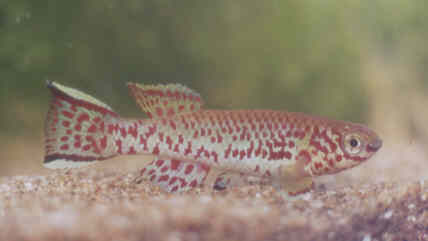Fundulopanchax gardneri gardneri (Boulenger 1911)

This fish was distributed in the BKA in the 1980's as A.gardneri gardneri.
| Meaning of Name |
After Captain R.D.Gardner. Boulenger (1915) spells his name Gard'ner. |
| First Description |
Boulenger G.A. 1911. (Fundulus gardneri). Descriptions of New African Cyprinodont Fishes. Ann. & Mag. Nat. History. Series 2 : (8) 8 (44): p 261. |
| Size |
7 cm |
| Meristics |
|
| Karyotype |
n = 18, A = 34 (Scheel 1972) |
| Sub-Genus |
Paraphyosemion |
| Group |
gardneri |
| Synonyms |
|
|
Populations
|
Click on list to left for more detailed information on each population. Telemu
- Background colour on body & fins blue/green. Small red spots on
body & all unpaired fins. No outer marginal bands or lines in unpaired
fins. |
| Type Locality |
Okwoga. Situated at the headwaters of the Cross River, southeastern Nigeria. Boulenger 1915 also lists collections from :-
|
| Distribution |
Udi mountains in the upper Cross River drainage system, northwards into the lower Benue River drainage of eastern Nigeria. Click link to map of gardneri distribution. This comprises all populations I can find on maps. You can zoom in but markers are not accurate to the exact collection spot, just the area which builds up a picture of distribution. map |
| Habitat |
Swamps, small pools & swampy areas of brooks in humid rainforest & savannah. |
| Distinguishing Characteristics |
Fairly easy to seperate from other sub species by having a very spotted body on a green/blue background. Anal fins are spotted & have no outer marginal band. The Lafia population can be distinguished by a more greener background colouration to the upper body. |
| Colour/Pattern Variability | Fp.gardneri gardneri populations fairly low. Not to be confused with other sub species or Fp.nigerianus. |
| History |
First described as Fundulus gardneri by G.A.Boulenger in 1911. The 3 type specimens were collected by Captain R.D.Gardner at Okwoga, south eastern Nigeria & measured 60 mm in length. In the same year he described Haplochilus brucei collected by Major G.E.Bruce from a pool at Udi from the Cross River drainage . Later (1915) he considered brucei to represent a synonym of gardneri. Boulenger gives the following collectors / locations in his 1915 Catalogue.
In 1976 Wright & Roberts collected a population near the Catholic mission at Lafia. History of the synonym Haplochilus brucii Boulenger 1911 Boulenger described the sp. in 1911 from 8 specimens collected in a pool at Udi, Cross River drainage. He later ( 1915 ) considered the sp. as a synonym for gardneri. |
| Breeding Notes |
Easily spawned. If you can't breed these it's time to hang up your mops! Eggs are laid in top & bottom mops which can be collected & stored in a seperate container. They can be water stored for 14-21 days or laid on wet peat where they can be left to incubate for 4 weeks (some will go to 6 weeks). Fry will eat newly hatched brine shrimp as a first food. Growth rate rate is quite fast with sexual maturity showing at around 5-6 weeks. A blue phase fish was tank bred from yellow phase Nsukka. This is not unusual for gardneri. |
| Diameter of Egg | 1.1 mm |
| Remarks |
|